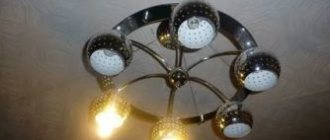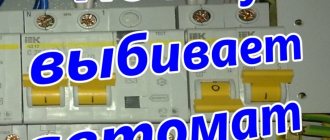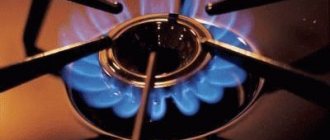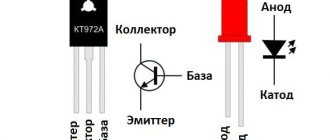Physics of heating
According to the Joule-Lorentz law, “The amount of heat released per unit time is proportional to the product of the square of the current in the area and the resistance of the conductor.”
Then everything is simple:
If the current increases in a section of the circuit, then the heat generated increases by the square of the current, that is, very strongly. Without an emergency, the current in the circuit may increase as the power consumption increases, for example, you plugged in a powerful household appliance or plugged many household appliances into one outlet. This is the first reason for heating the wires.
The increase in heat generated may be associated with an increase in the resistance of the current flow section. This property is used in all electric heaters where high resistance coils are heated. In wiring, an increase in section resistance may be due to weakening or oxidation of electrical contacts when connected by a conductor or connected to each other.
These two reasons, a significant increase in power consumption and weakening of the electrical contacts in the circuit, are the main reasons for the heating of the conductors and the reason why the wiring heats up is most likely in them. You can read: Major electrical hazards in the home
Why does the wire get hot?
A section of the route covered with photovoltaic panels will allow you to earn up to $15 a year in energy production BEIJING, December 22. /TASS/. A highway covered with photovoltaic panels in the Chinese city of Jinan (the administrative center of Shandong Province, Eastern China) will allow you to earn about $15 per year from electricity generation per square meter. meters. Commissioning will take place before the end of the year, China Daily reported on Friday. Solar panels cover one lane and the shoulder of one section of the city bypass highway. Their total length is 1.12 kilometers, and the area of photovoltaic panels reaches 5,870 square meters. meters. According to calculations, the peak power of this section of the route will be 817.2 kW. After commissioning, this electricity will be discharged into the city’s power grid. "1 sq. meter of photovoltaic road can earn at least 100 yuan (about $15) per year from electricity generation,” Zhang Hongchao, the chief engineer of the project, a professor at Tongji University (Shanghai), told the publication. “However, much more profit can be made through the services that coverage can provide through third parties,” he said. “Among them, wireless charging of electric vehicles, as well as navigation services for unmanned vehicles,” said the project curator. He noted that to date, the project organizer has reached an agreement with the American corporation Qualcomm to provide technology for wireless charging of electric cars moving along the highway within two to three years. According to the developers, from an economic point of view, solar panels are not inferior to conventional concrete and asphalt. They can withstand the movement of all types of transport on them, and their service life is 20 years. In September, the company built a test section of this road with a length of 160 meters and an area of 600 square meters. meters in the city center. The energy generated by the photovoltaic panels was supplied to nearby charging stations for electric vehicles. In 2006, the United States began studying technology for building highways with built-in photovoltaic elements. In 2014, the first such road was constructed in the Netherlands: its length and width were 70 meters and 2 meters, respectively. However, it was only accessible to pedestrians and cyclists. The first highway with photovoltaic panels was built in France - its length reached 1 kilometer. https://tass.ru/ekonomika/4834329 *** They are completely furious, damn the commies - they are already paving the roads with solar panels. That's what 9 grams of miracle workers do. Or how do they deal with swindlers and thieves in China? Hanging? Are they toasting? Yes, not the essence, these are details, the main principle is. But if they were engaged in democracy there, then instead of a road made of solar panels they would now have some Chinese Gru Di Ning, recommended for nomination for elections as an alternative to the Chinese Pu Ti Nu - and that’s all. *** While wild and fantastically greedy native dictators and despots are fighting to sell an extra liter of oil and gas, developed countries are testing technologies that will come in the near future. And which will make oil and gas ordinary goods, and not a strategic resource. Russia is increasingly falling into a ditch on the edge of civilization. Having received a gift from heaven in the form of unreasonably high oil prices and hitting a completely random jackpot, our ignorant leaders blew it, like an alcoholic who won the lottery and drank away the winnings in a matter of months. All investments in the future are villas and castles in Europe and sports megaliths of abandoned Cyclopean Stonehenges on our territory. In fact, these neo-Coliseums, pecked by cormorants, are the only thing that will ultimately remain of Putin’s mafia civilization. And an empty pipe. There will be nothing else after thieves and bandits.
But still, the main topic in Russia remains: is there life after Putin? If not him, then who will save us orphans from the terrible Maidan. Although the formulation of the question should be fundamentally different: who will finally be able to formulate and launch a project to return the country to its rightful place among the advanced and technologically developed powers. Not Putin for sure. He has already demonstrated his abilities and, frankly speaking, they are not impressive. Putting something created by the labor of generations into the pockets of friends is a simple matter. That is, the professional skills of pickpockets, of course, are needed so that the victim does not even feel how his wallet is being cut - here, with the skill of the current ones, everything is in perfect order. The rest, not so much.
What if the neutral wire gets hot?
It is a rare case when the neutral wire in the electrical panel begins to heat up. For example, when recently laying a resistive cable for floor heating in an apartment. You should know that there is no life-threatening potential on the neutral conductor, and its temperature should be within room temperature, but not higher.
What could cause this heating?
- With uneven distribution of currents. This means that at the working zero the current strength exceeds the current that passes through the phases. Self-regulating cables, which are used to heat pipes, lead to this result due to their power. In this case, the zero can not only overheat, but also burn out.
- Poor contact of the neutral wire with the neutral bus. Accompanied by an unpleasant crackling sound and sparking. It is enough to tighten the contact or check the nearest place of twisting and the problem will be eliminated.
- Connecting electrical devices that directly affect the frequency. These are: induction furnaces, pulse consumers, heating cables, LED-based lighting sources, etc.
Consequences of poor-quality neutral wire contact
The above malfunctions are often a consequence of one problem - poor contact. Of course, there are other reasons: poor cable quality, inappropriate circuit breaker, old wiring and much more. But the most common is a contact that interferes with the electrical energy passing through the conductor.
To avoid the consequences of excessive heating of the cable, it is necessary to periodically check the connections in electrical panels and distribution boxes, and, as necessary, tighten or tighten the twists or terminal blocks.
Causes of bad contacts
Let us highlight several reasons for poor contacts in electrical wiring.
- Incorrect wire connection.
- Operational loosening of screw terminals.
- Poor quality installation product.
- Violation of connection rules.
Incorrect conductor connection
We will talk about incorrect connection of conductors in the next article. Here I note that it is preferable to use special terminal blocks to connect two conductors.
Operational loosening of screw terminals
Over time, any screw clamp that is not tightened will weaken. For electrical wiring, the recommended period for tightening contacts in switchboards is 6-8 years (departmental instructions). The same period can be applied to the wiring of contacts in sockets and switches.
The use of devices and products with non-screw connections will help to avoid pulling screw contacts. The contacts of such devices are constantly pressed by a spring.
Poor quality installation product
Poor quality of the purchased socket, switch, or protective device may be the cause of poor connection contact.
Violation of connection rules
When connecting a socket, switch, circuit breaker, you must strictly follow the connection rules. For example:
- When connecting a cable of sockets, use wires of the same cross-section for the cable jumpers. This will prevent contact distortion;
- If you need to connect wires of different sections to a contact, make rings at the end of the wires to connect to the contact. Such a connection requires the purchase of installation products with no input;
- Do not connect more wires than specified in the instructions for the device. For example, look at the Legrand outlet. The design of the socket itself says that more than two wires cannot be connected to one contact (elderly input).
Related articles: Aluminum wiring: pros, cons, myths, what lies ahead
Particular attention should be paid to connecting circuit breakers and protection devices. More about this here, and briefly here. If you look at the contacts of machines made by different manufacturers, we will see that there are flat contacts (for example, IEK), and there are semicircular ones (for example, ABB). Also, two-pole and three-pole ABB circuit breakers have two contact groups, one for the comb, the second for the wire. What does this mean?
- According to the manufacturer's instructions, only one wire can be inserted into a circuit breaker with a semicircular contact.
- Either one or two wires can be inserted into a circuit breaker with direct contact.
- To connect machines with a cable, it is better to use connection combs.
- Contacts on circuit breakers and protective devices must be tightened with a load according to the manufacturers' instructions. Typically, 2.8 N/m.
The main reasons for heating cables and wires
To understand the reason for the heating of electrical wiring, you need to remember the basics of electrical engineering. Electric current is the ordered movement of free electrons, in the path of which other atoms of a substance appear. A certain number of such atoms is called electrical resistance. If the resistance is too high, the temperature of the material increases.
An example of securely tightened wires
This principle is successfully applied, for example, in water heaters. In other household appliances or the electrical network, it is necessary, on the contrary, to reduce the heating of the conductors - to bring it to the nominal level.
The main reasons for heating cables and wires:
- The main reason why the wire heats up is the choice of its wrong cross-section. When choosing a small cross-section of wires, which haunts almost all would-be electricians, and a constant current strength, a rapid increase in the temperature of the cable occurs. The same principle applies to water pipes - the larger the diameter, the greater the water pressure.
- Overheating of the line occurs due to improper installation. For example, a minor short circuit that does not respond to an overrated circuit breaker. The machine does not open the line - the cable continues to heat up, and after a while it burns out.
- Poor quality connection or oxidation of contacts. Aluminum wires oxidize very quickly, the connections of which should be checked more often than copper wires. In order not to worry about the quality of twisting, it is better to use special terminal blocks or carefully solder the cables.
- Using a low quality cable or wire. Now the electrical equipment market is rapidly filling with products from Korea and China, the quality of which leaves much to be desired. Such a cable, even if installed correctly, can itself cause heating and fire.
Ways to solve the problem
So, there is a difference between the fact that the electrical wiring in the house heats up or the cord from a household appliance heats up. In this regard, the repair technology will differ. To make the material clearer to you, let’s look at individual examples of what needs to be done and how.
If you notice that the wire from a water heater or washing machine is heating up, the first thing you need to do is determine how the heating occurs: in one specific place or along its entire length. Most often, the plug connected to the socket heats up. This is due to the fact that there is poor contact between the socket terminals and the power supply wires. Because of this, the outlet terminals heat up, and all the heat transfers to the electrical plug. In addition to poor contact, the cause of malfunctions can be a weak socket (for example, rated at 10 A). The fact is that powerful electrical appliances: a stove, a boiler, a heater, and even some kettles function normally only when connected to a 16-amp outlet or directly from the panel (if the power exceeds 3.5 kW). As you can guess, a 10-amp outlet will not withstand high loads and will begin to heat up, melt (as in the photo below) and after which a short circuit may occur after a short period of time.











